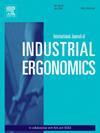Differences in types and causes of human errors between high-speed and conventional railway dispatching: the potential impact of automation
IF 3
2区 工程技术
Q2 ENGINEERING, INDUSTRIAL
International Journal of Industrial Ergonomics
Pub Date : 2025-07-19
DOI:10.1016/j.ergon.2025.103790
引用次数: 0
Abstract
Dispatcher errors are critical for railway safety, yet the impact of new technology on error types and causes is less understood. High-speed railways (HSR) utilize advanced automated technologies that enhance efficiency but introduce new challenges. This study analyzed 8522 error records from both HSR and conventional rail (CR) dispatchers using a human error classification framework. We categorized these errors into three key task types: monitoring, planning and scheduling, and dispatching instructions. Results showed that HSR dispatchers make more errors in planning and scheduling tasks, particularly decision-making errors influenced by poor crew resource management and adverse mental states. In contrast, they make fewer errors in monitoring and dispatch instructions, with reduced decision errors and violations. Additionally, skill-based errors were less affected by factors such as personal readiness and supervisory issues. We explained these findings by linking them to how automation reduces procedural workload, decreases controllability and predictability, and induces out-of-the-loop unfamiliarity.
高速铁路和常规铁路调度的人为错误类型和原因的差异:自动化的潜在影响
调度员错误对铁路安全至关重要,然而新技术对错误类型和原因的影响却鲜为人知。高铁利用先进的自动化技术提高了效率,但也带来了新的挑战。本研究使用人为错误分类框架分析了高铁和常规铁路(CR)调度员的8522条错误记录。我们将这些错误分为三种关键任务类型:监视、计划和调度以及调度指令。结果表明:高铁调度员在计划和调度任务上的失误较多,尤其是决策失误,主要受机组资源管理不善和不良心理状态的影响。相比之下,他们在监控和调度指令方面的错误更少,决策错误和违规行为也更少。此外,基于技能的错误受个人准备和监督问题等因素的影响较小。我们通过将这些发现与自动化如何减少程序性工作负载、降低可控性和可预测性以及引起环外不熟悉联系起来,来解释这些发现。
本文章由计算机程序翻译,如有差异,请以英文原文为准。
求助全文
约1分钟内获得全文
求助全文
来源期刊
CiteScore
6.40
自引率
12.90%
发文量
110
审稿时长
56 days
期刊介绍:
The journal publishes original contributions that add to our understanding of the role of humans in today systems and the interactions thereof with various system components. The journal typically covers the following areas: industrial and occupational ergonomics, design of systems, tools and equipment, human performance measurement and modeling, human productivity, humans in technologically complex systems, and safety. The focus of the articles includes basic theoretical advances, applications, case studies, new methodologies and procedures; and empirical studies.

 求助内容:
求助内容: 应助结果提醒方式:
应助结果提醒方式:


